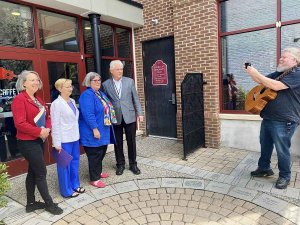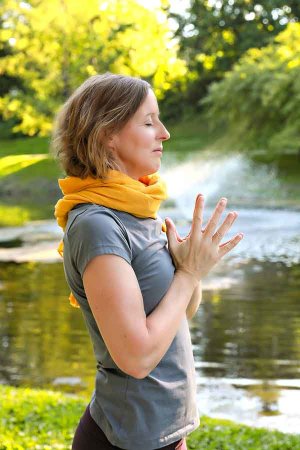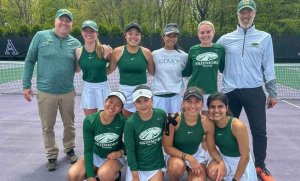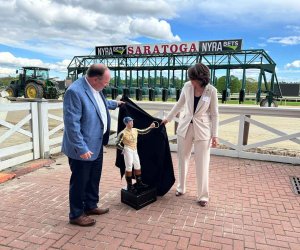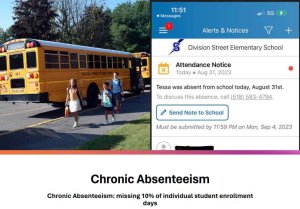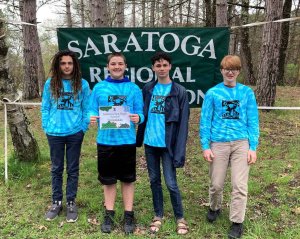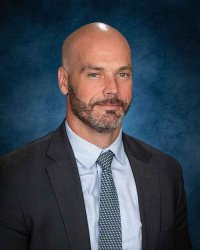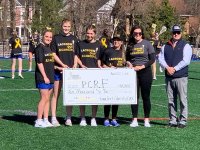Khuriun, a native of the indigenous Nivkh community in Russia, was one of six indigenous Russians to visit the Ndakinna Education Center (NEC) February 15 in their hopes to learn more about native peoples’ sustainable management practices in the United States.
The group’s stop at the NEC was just one of many during their two-week tour of native communities in the United States. Before reaching upstate New York, the group traveled to Portland, Ore. and Albuquerque, N.M. to visit with native groups in their efforts to see how indigenous groups in the U.S. preserve their traditional economic activities, culture and language and survive in a modern economic environment.
The program was facilitated by the U.S. Department of State’s International Visitor Leadership Program, with the local visit being organized by the International Center of the Capital Region office.
Joe Bruchac, executive director of the NEC, led the group in sharing native stories, traditions and answering questions about the native Abenake culture.
As the Russians settled into the group circle, Joe and his son, Jesse, welcomed them with a traditional welcome song played on a bongo drum and shaker while they both sang in the Abenake language—Joe informed the group afterwards that the Abenake language is one of the most endangered in the world, with only a dozen fluent speakers left.
After the traditional welcome song, Joe began to speak about the Abenake and Mohawk culture and how they try to sustain it.
“’Ndakinna’ means ‘our land,’” Joe explained, pausing to let the translator speak quietly through a microphone attached to ear pieces for each of the Russian natives. “We are people of this area and this region. We try the best we can to educate, share and hold onto our land, stories, traditions—it’s very important to us.
“We teach old skills like how to track animals, make shelters, tell stories, sing songs, and teach the arts of life—a strong mind, heart, spirit and body,” Joe continued. “So we also teach martial arts here,” he added with a laugh.
He then passed around a “talking stick,” a Native American custom in which whoever has the stick is the one with permission to speak to the group. The stick was passed around the whole circle to give each Russian a chance to speak about themselves and their culture.
Olga Yurievna Khuriun spoke about how there are only 4,600 people left in her tribe in the Yuzhno-Sakhalinsk region, located on an island in the far southeast region of Russia. Khuriun has organized numerous cultural festivals and has a special interest in helping young people maintain indigenous culture and rights.
Aleksei Victorovich Kudriavtcev, a native Russian, is a hunting inspector at the indigenous community “Tiger” in the town of Krasny Yar in the Pozharskiy District. He advocates for the rights and interests of indigenous peoples and works to protect areas of their traditional economic activities, like hunting and fishing.
Alexander Gavrilyevich Grigorev, a member of the Evenk Nomadic Clan, is the chairman of the Association of the Indigenous Clans of Yukitiya, which currently overseas almost 200 clans. Grigorev spoke about how his tribe lives in the coldest region of the planet, located in the far east region of Russia where the weather can drop to -65 degrees on a cold, arctic night.
“The southern part of our region is industrially developed, but [development] is moving north,” Grigorev explained. “There is now a migration of people coming into our area. You look very much like our people in the way you look physically but also in spirit,” he added with a smile.
As introductions were made, common ground between the groups was found in little things, such as when Joe showed the group one of his favorite books—which happened to be written by a Siberian author whom the Russians recognized. The group also had some small talk about how each group grows and eats mushrooms, nodding and laughing as they began to understand each other more. Joe then led the group to the center’s gift shop and original hut replica for a little show-and-tell session.
The NEC has a presentation room full of cultural exhibits, showcasing native tools, baskets, rattles, drums, shelters, clothing and even a full-scale birch bark canoe. The group also explored the outdoor grounds of the center, taking pictures, pointing at hawks in the sky and looking for animal tracks in the woods.
“We did a lot of laughing together—and throwing snowballs at each other when we were walking in the woods,” Joe said after the meeting. “Communicating beyond the language barrier with body language, with reading each other's faces, with smiling—I really felt as if it was more like connecting with cousins we'd not met before.”
Joe also said he was excited by how much the groups had in common with each other.
“Our goals—including the survival of our indigenous languages and cultures and our concern for not only our own unique ecosystems, but for the health of the planet itself—are very much the same,” Joe said. “I also discovered what I've suspected for some time—that their sense of humor was very much like that of American Indians.”
As far as the future is concerned, Joe said he is hopeful that the groups will keep in contact and continue to learn more about each other.
“[I think] they learned of us, recognized us in a way—for example, when we did our greeting songs or when Jesse played the flute for them, and they nodded in pleasure and understanding,” Joe explained. “I believe they saw that we were allies in many ways, and we established a connection which I think they, and certainly we, hope to be able to continue.”
The cultural exchange between the NEC and indigenous Russian group was arranged by the ICCR, a nonprofit which promotes professional and cultural exchanges. Members and participating organizations serve as citizen diplomats by hosting international visitors and delegations. To learn more about the ICCR, visit the website at www.iccralbany.org. To learn more about the Ndakinna Education Center, visit www.ndakinnacenter.org.




 How to resolve AdBlock issue?
How to resolve AdBlock issue? 